

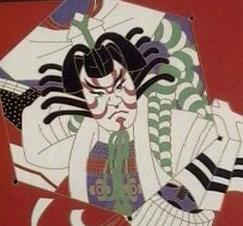 |



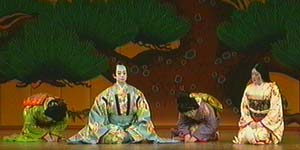
than drama, it is spectacle! It is a feast for the
eyes, a delight for the ears and an occassion
for feeling and expressing emotion.
According to legend, kabuki had
its origin in
the early seventeenth century
when a renegade
Shinto priestess (Okuni) and
her troupe of dancers
and actors began performing dances in
the dry
river beds in the ancient capital of
Kyoto. Soon
other troupes of female dancers
began to lure
audiences with their sensuous
performances as
well as their off stage activities.

In the early years, the
interests of such
acting groups seems to have
been more in sex
than in serious dramatic
performance. Alarmed
by the immorality of the
theater, the government
banned all
women performers from the stage in
an effort
to safeguard the public's morals.
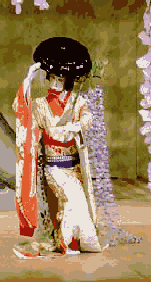
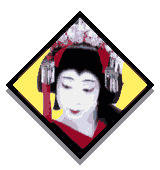

This move radically changed the direction of Kabuki was, in many ways, a child of the Genroku era,
when the merchant class emerged as a strong
economic force in the urban areas.Common
people soon became enamored of these dramas
with their gaudy and bright costumes, violent
actions and strong emotional tension; the
colorful day-long performances attracted
people from
kabuki, because now, more importance was
placed on skill over beauty and more stress placed
on
drama than dance. These changes put kabuki
on
the path of developing into a dramatic art
form
and the ban on women performers
resulted in the
appearance of the "onnagata",
men who became
highly skilled in playing women's roles. Some
of
kabuki's greatest actors have
gained a large
following by specializing in just such roles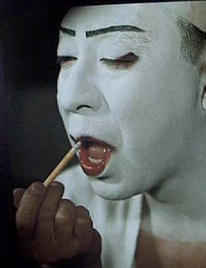

all ranks of society, shop
keepers
and merchants to samurai.
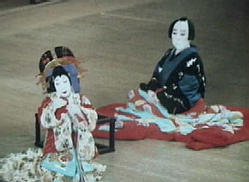
To
appreciate its appeal, one must see kabuki
as
a fusion into a single form of the arts of
music,
dance, acting, literature as well as
the graphic arts.
Color and motion are
important elements in kabuki;
ingenious
mechanical devices such as the
revolving
stage, trapdoors, and the passageway
('hanamichi"-flower road) that runs directly
through
the audience enabled production
managers to
heighten the dramatic effects of
the plays.

Kabuki had its
ownShakespeare in the person of A favorite theme
was the love suicide drama.
Chikamatsu
Monzaemon (1653-1725) who wrote
more than one
hundred and sixty dramas and
puppet plays. His plays dealt not only with
significant
historical events but also with the
lives of
ordinary people of his time.
The plot
usually involved a hero who was either a
samurai or townsman and a heroine who was a
courtesan from the "pleasure quarters"
("yoshiwara"). The focus then was on the
conflict between love and duty or "ninjo" (human
feelings) and
"giri" (social and moral obligations).
Too
often, the only solution to this conflict for
the lovers was suicide. This struggle between
"ninjo" and "giri" continues to be a
constant
in Japanese life.
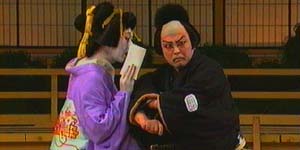
As a
"traditional" form of theater, kabuki
today faces competition from modern forms
of entertainment like
movies and television.
Its position as "traditional theater"
often
makes it seem "stuffy" to some.
Still, the
kabuki stage is very much alive
today, being
ably maintained by hereditary
lines of great
actors at the kabuki theater in
Tokyo
("Kabukiza") and elsewhere in Japan.
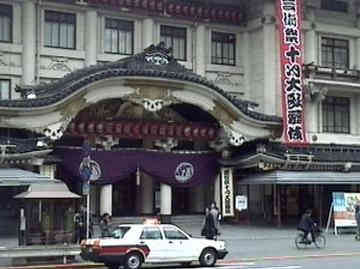
 ~NEXT~
~NEXT~

